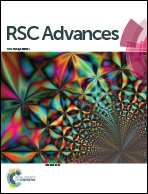Selective Wacker type oxidation of a macrocyclic diene to the corresponding monounsaturated ketone used as fragrance†
Abstract
A selective reaction method for the efficient conversion of an isomeric mixture of 1,9-cyclohexadecadiene (1,9-CHDD) to the corresponding monounsaturated cyclohexadec-8-en-1-one (8-CHD) is described. 8-CHD was synthesized via Wacker type oxidation at room temperature using a highly electrophilic in situ formed dicationic palladium species. Isomerisation of the diene and over-oxidation of the substrate could be nearly suppressed by suitable reaction control, which has a positive effect on selectivity. The utilization of molecular oxygen as a green oxidant and environmentally benign iron(III) salts as co-catalysts was successfully applied. This reaction strategy is promising to overcome the low overall reactivity of internal olefins in Wacker type oxidations. In addition, larger scale experiments showed further potential for industrial application.



 Please wait while we load your content...
Please wait while we load your content...